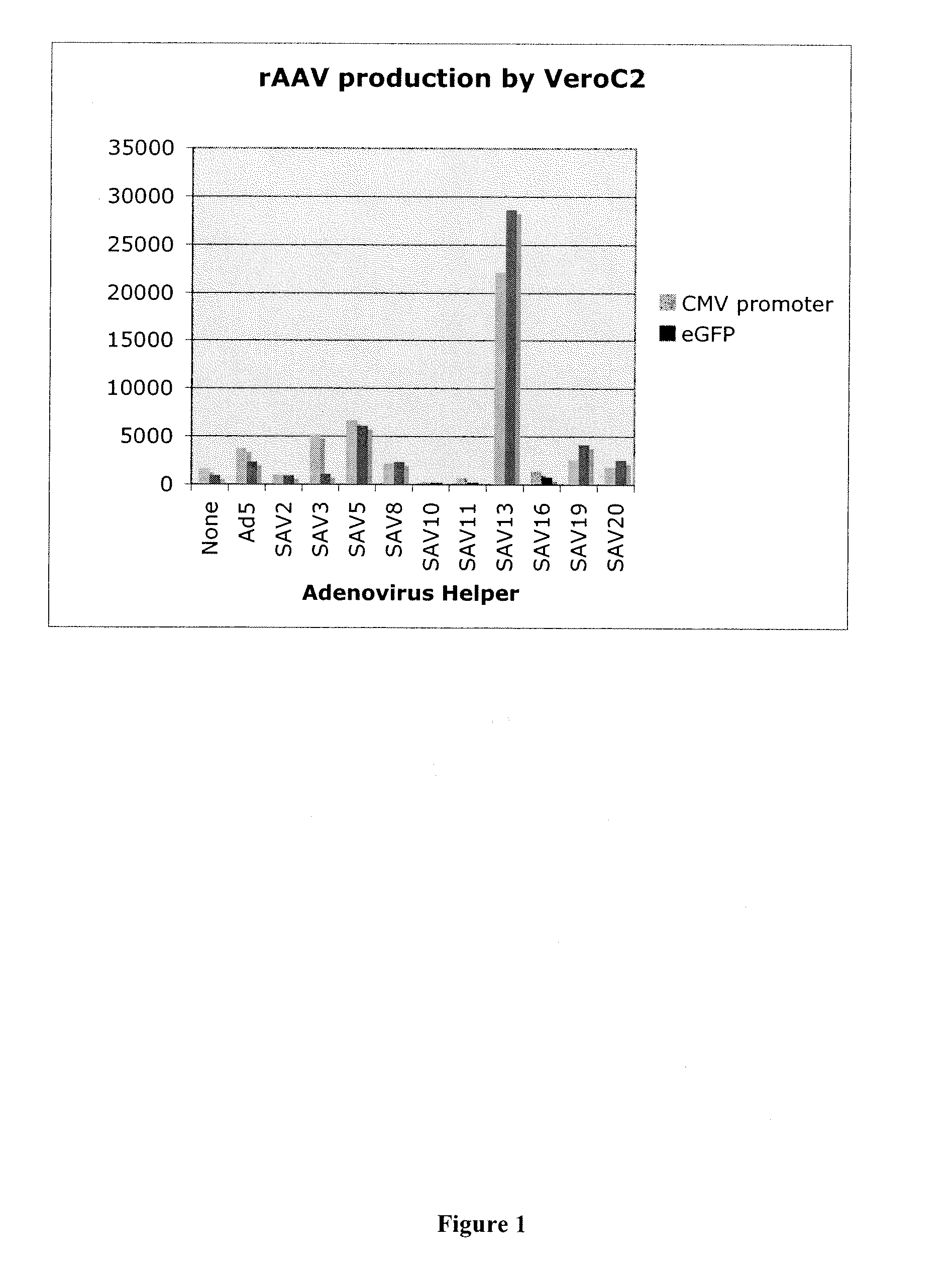Production of rAAV in vero cells using particular adenovirus helpers
a technology of adenovirus and helper, which is applied in the direction of viruses/bacteriophages, dsdna viruses, biochemistry apparatus and processes, etc., can solve the problems of difficult scaling up of transfection methods, aav-infected cells are not resistant to superinfection, and the general implementation of raav remains obstructed, so as to achieve high titer production of raav. , the effect of high
- Summary
- Abstract
- Description
- Claims
- Application Information
AI Technical Summary
Benefits of technology
Problems solved by technology
Method used
Image
Examples
example 1
[0044]The effect of use of various simian adenovirus helper viruses on rAAV expression of a heterologous gene in Vero cells was examined.
[0045]Simian adenoviruses were obtained from the American Type Culture Collection (ATCC, Manassas, Va.) and propagated by infecting LLC-MK2 cells (ATCC) in DMEM with 2% supplemented calf serum (Cosmic Calf Serum, HyClone, Logan Utah). Cleared cell lysates were prepared by four rounds of freezing and thawing followed by centrifugation to remove particulates. Virus samples were checked for the presence of wild type AAV by a PCR assay with degenerate primers as described in Chen et al., J Virol 79: 14781-14792 (2005). Viral samples that showed the presence of contaminating wild type AAV were processed by plaque purifying virus in the presence of anti-AAV1 rabbit antiserum. The PCR assay was then repeated on the new viral stocks. Viruses were titered by the TCID50 method on LLC-MK2 cells as described in the Adeno-X expression system 1 User Manual, page...
example 2
[0048]The effect of use of various simian adenovirus helper viruses on rAAV particle production in Vero cells was also examined.
[0049]The level of production of rAAV was measured by the DNAse-resistant particle (DRP) assay. Vero C2 cells were infected at an MOI of 10 with SAdV-2, -3, -5, -8, -10, -11, -13, -16, -19, or -20. When infected cells showed maximal cytopathic effect (CPE) (evidenced by rounding and detachment) they were harvested and subjected to 4 freeze thaw cycles to lyse the cells and release the virus. Heat treatment was used to inactivate residual Ad5 (55° C. for 30 min). The samples were then diluted 1:1,000 in 50 mM KCl, 10 mM Tris pH 8.0, 5 mM MgCl2 and 50 μl of the diluted lysate was treated with DNAse I for 30 min at 37° C. The DNAse was heat inactivated at 95° C. for 10 minutes and 10 μg of Proteinase K was added and allowed to digest the rAAV capsid for 1 hr at 50° C. and then the Proteinase K was inactivated by heating at 95° C. for 20 minutes. The net effect...
example 3
[0053]The CPE of various helper viruses was examined.
[0054]The time to reach maximum CPE was examined for various viruses by infecting cells at MOI 10, then examining their morphology daily by phase contrast microscopy with an inverted microscope. The time to maximal CPE was defined as the first day at which at least 95% of the cells show definite rounding.
[0055]For simian adenoviruses 1, 2, 3, 5, 7, 8, 10, 11, 16, 19, and 20 on Vero cells, the time to maximal CPE was 2-3 days. For HuAd5 on Vero cells the time to maximal CPE was 3-4 days, while for HuAd5 on HeLa cells it was 2 days. For SAdV-13 on Vero cells the time to maximal CPE was 5 days.
PUM
| Property | Measurement | Unit |
|---|---|---|
| time | aaaaa | aaaaa |
| time | aaaaa | aaaaa |
| time | aaaaa | aaaaa |
Abstract
Description
Claims
Application Information
 Login to View More
Login to View More - R&D
- Intellectual Property
- Life Sciences
- Materials
- Tech Scout
- Unparalleled Data Quality
- Higher Quality Content
- 60% Fewer Hallucinations
Browse by: Latest US Patents, China's latest patents, Technical Efficacy Thesaurus, Application Domain, Technology Topic, Popular Technical Reports.
© 2025 PatSnap. All rights reserved.Legal|Privacy policy|Modern Slavery Act Transparency Statement|Sitemap|About US| Contact US: help@patsnap.com



